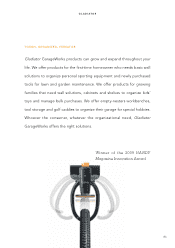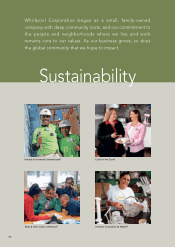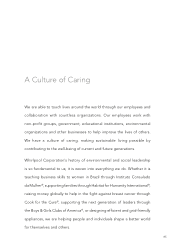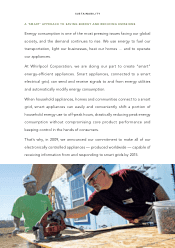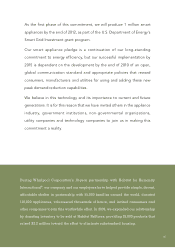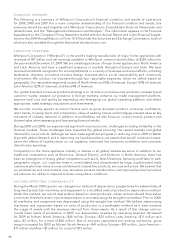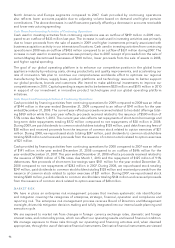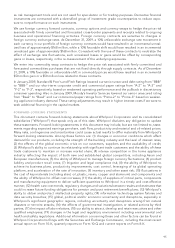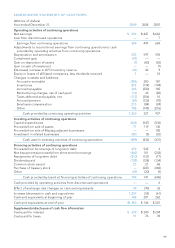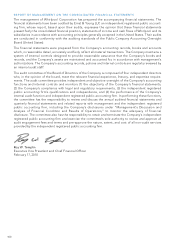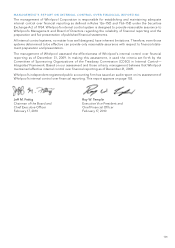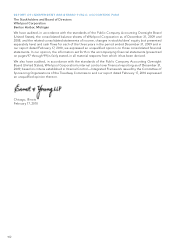Whirlpool 2009 Annual Report Download - page 96
Download and view the complete annual report
Please find page 96 of the 2009 Whirlpool annual report below. You can navigate through the pages in the report by either clicking on the pages listed below, or by using the keyword search tool below to find specific information within the annual report.
The table below reconciles projected 2010 cash provided by operations determined in accordance with
generally accepted accounting principles (GAAP) in the United States to free cash flow, a non-GAAP
measure. Management believes that free cash flow provides shareholders with a relevant measure of
liquidity and a useful basis for assessing Whirlpool’s ability to fund its activities and obligations. There
are limitations to using non-GAAP financial measures, including the difficulty associated with comparing
companies that use similarly named non-GAAP measures whose calculations may differ from our calcula-
tions. We define free cash flow as cash provided by continuing operations after capital expenditures and
proceeds from the sale of assets/businesses.
The projections shown here are based upon many estimates and are inherently subject to change based
on future decisions made by Management and the Board of Directors of Whirlpool, and significant
economic, competitive and other uncertainties and contingencies.
(Millions of dollars) 2010 Outlook
Cash provided by operating activities $ 925 –$1,025
Capital expenditures (525)– (575)
Proceeds from sale of assets/businesses — – 50
Free cash flow $ 400 –$ 500
FI N A N C I A L C O ND IT IO N A N D L I QU ID IT Y
Our objective is to finance our business through operating cash flow and the appropriate mix of long-term
and short-term debt. By diversifying the maturity structure, we avoid concentrations of debt, reducing
liquidity risk. We have varying needs for short-term working capital financing as a result of the nature of
our business. The volume and timing of refrigeration and air conditioning production impacts our cash
flows and consists of increased production in the first half of the year to meet increased demand in the
summer months.
The funding markets have been volatile during the majority of 2008 and 2009 and we have experienced
negative global economic trends. To succeed in this environment we have aggressively taken steps to
further reduce all areas of cost, production capacity and working capital. As a result of the global volatility
and challenging economic trends, we decided to exit the commercial paper market during the December
2008 quarter and initiated borrowing under our committed bank line of credit (“Credit Agreement”),
provided by a syndicate of highly-rated banks. Outside the U.S., short-term funding is provided by bank
borrowings on uncommitted lines of credit.
On February 27, 2009, we entered into an Amendment (the “First Amendment”) to the Credit Agreement
to assure flexibility in future credit availability. The First Amendment increased the spread over LIBOR to
3%, the spread over prime to 2% and the utilization fee to be paid, if amounts borrowed exceed $1.1 billion,
to 1% and replaced the facility fee with an unused commitment fee of 0.50%.
On August 13, 2009, we entered into a second Amendment to our Credit Agreement (the “Second
Amendment”) to further assure flexibility in future credit availability. The Second Amendment divides and
reduces the existing $2.2 billion credit facility into a $1.35 billion tranche maturing on August 13, 2012 (the
“Extending Tranche”) and a $522 million tranche maturing December 1, 2010 (the “Non-Extending
Tranche”). For the Extending Tranche, the Second Amendment provides a utilization fee to be paid, if
amounts borrowed exceed 50% of the facility, of 0.50%, and for the Non-Extending Tranche, the utilization
fee to be paid, if amounts borrowed exceed 50% of the facility, is 1%. The interest margin over LIBOR
charged will be based on Whirlpool’s credit rating.
As of December 31, 2009, there was no balance outstanding under our credit facility.
On May 4, 2009, we completed a debt offering comprised of (1) $350 million aggregate principal amount
of 8.00% notes due 2012 and (2) $500 million aggregate principal amount of 8.60% notes due 2014. The
proceeds from the notes were used for general corporate purposes.
We believe that our operating cash flow, together with access to sufficient sources of liquidity, will be
adequate to meet our ongoing funding requirements. We are in compliance with financial covenants in our
credit facility for all periods presented.
92



